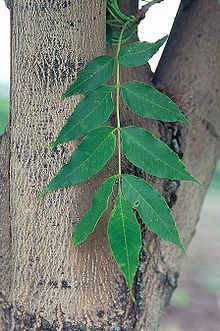- Fraxinus mandschurica
-
Fraxinus mandschurica 
Manchurian Ash leaf and bark Scientific classification Kingdom: Plantae (unranked): Angiosperms (unranked): Eudicots (unranked): Asterids Order: Lamiales Family: Oleaceae Genus: Fraxinus Species: F. mandschurica Binomial name Fraxinus mandschurica
Rupr.Fraxinus mandschurica (Manchurian Ash) is a species of Fraxinus native to northeastern Asia in northern China, Korea, Japan and southeastern Russia.[1]Also Known as 'Chinese Oak'.
It is a medium-sized to large deciduous tree reaching 30 m tall, with a trunk up to 50 cm in diameter. The leaves are 25-40 cm long, pinnate compound, with 7-13 leaflets, the leaflets 5–20 cm long and 2–5 cm broad, subsessile on the leaf rachis, and with a serrated margin. They turn to a golden-yellow in early autumn, and the tree is usually early to change color. The flowers are produced in early spring, before the new leaves, in compact panicles; they are inconspicuous with no petals, and are wind-pollinated. The fruit is a samara comprising a single seed 1-2 cm long with an elongated apical wing 2.5-4 cm long and 5-7 mm broad.[1]
It is closely related to Fraxinus nigra (Black Ash) from eastern North America, and has been treated as a subspecies or variety of it by some authors, as F. nigra subsp. mandschurica (Rupr.) S.S.Sun, or F. nigra var. mandschurica (Rupr.) Lingelsheim.[1]
The spelling of the species name is disputed; some (e.g. the Flora of China[1]) cite mandschurica, while others (e.g. USDA GRIN[2]) cite mandshurica.
Ecology
It is tolerant of many soil conditions including the wet soils of swamps and river valleys, and is not particular as to soil pH except for showing poor growth at high pH.[3] It requires full sun for optimal growth, and should receive at least 50 cm of precipitation each year. It requires a continental climate with well-defined seasons with cold winters, hot summers, and freedom from late spring frosts.[4]
The seeds are eaten by a wide variety of birds.
Uses
This tree is occasionally cultivated as an ornamental tree in parts of Canada and the United States. Manchurian Ash can be used as a medium height wind break for a farmstead. It is also highly tolerant of urban pollution and will even grow well in inner city environments. The tree also makes an excellent landscape tree in moist areas, especially along roads and ditches where a good amount of water can be available. The Manchurian grows into a denser oval form with age.
It has proved very intolerant of oceanic climate conditions in cultivation, leafing out too early and then being damaged by late spring frosts.[4]
The species is being tested as a potential source of genes for resistance to emerald ash borer Agrilus planipennis, an Asian insect which occurs alongside Manchurian Ash in the wild, and which has become an invasive pest species in North America.[5] However, significant mortality in Manchurian Ash from emerald ash borer is also recorded in the wild in China.[6]
The cultivar Fraxinus mandschurica 'Mancana' ("Manchana Ash") has been selected by the Morden Research Station, Morden, Manitoba. It has a dense oval to globose crown, and is a male tree; it is very hardy. Hybrids with Black Ash have also been produced in cultivation.[5]
References
- ^ a b c d Flora of China: Fraxinus mandschurica
- ^ Germplasm Resources Information Network: Fraxinus mandshurica
- ^ Alberta Government agriculture & food: Fraxinus
- ^ a b Bean, W. J. (1978). Trees and Shrubs Hardy in the British Isles 8th ed., vol. 2. John Murray ISBN 0-7195-2256-0.
- ^ a b Ohio State University: Ash Alert
- ^ European and Mediterranean Plant Protection Organization Data sheets on quarantine pests: Agrilus planipennis (pdf file) (currently unavailable; google cache)
Categories:- Fraxinus
- Trees of Russia
- Ornamental trees
- Trees of humid continental climate
Wikimedia Foundation. 2010.
